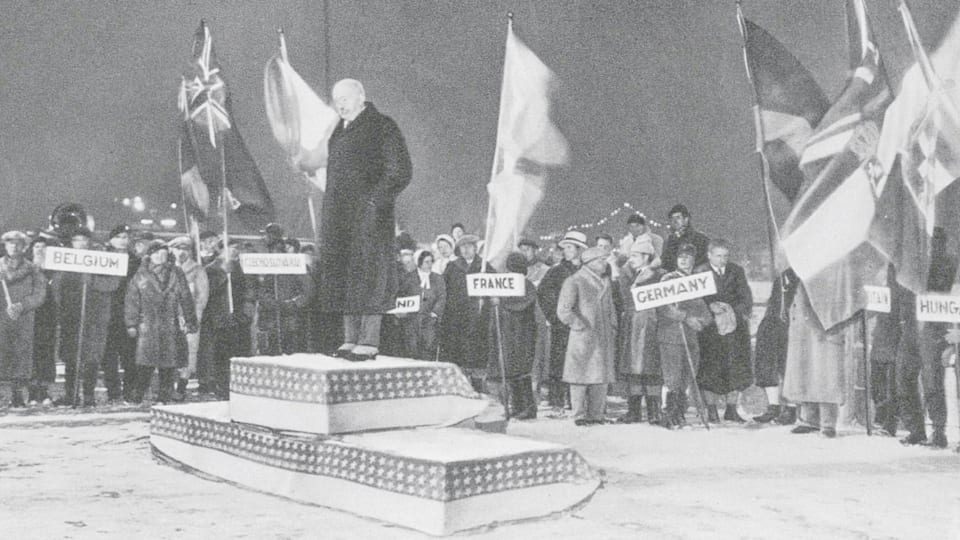1932: the podium makes its Olympic debut
The podium has become an iconic Olympic image and a core part of every athlete’s vocabulary. However, contrary to common belief, its origins lie not in Ancient Greece, but at the Olympic Winter Games 1932 in Lake Placid…

Until 1928, there was no set ritual for awarding the prizes to the winning athletes at the Olympic Games. During the first modern Games in Athens in 1896, the top three competitors in each event were awarded a medal, an olive branch and a certificate during the Closing Ceremony by George I, King of Greece. At the Olympic Games Amsterdam 1928, prize-winning athletes paraded in front of Queen Wilhelmina and her husband, Prince Henry, who were seated at a table in the VIP area of the Olympic Stadium, and who then handed out the prizes, again on the same day as the Closing Ceremony. Most commonly, these "collective" medal ceremonies saw the athletes stand below the dignitaries and officials awarding the medals.
De Baillet-Latour's bright idea
At the Olympic Games Antwerp 1920, Belgium's Victor Bonin took the first Olympic athletes' oath whilst standing on a platform in the middle of the Olympic Stadium. It was at the inaugural Empire Games (the forerunner to the Commonwealth Games) in Hamilton, Canada, in 1930, that a podium was first erected in the stadium for the athletics events. The winner stood on the top step (which had a wooden rail for the athletes to rest their hands on), while the second- and third-placed athletes stood one step below, to the right and left respectively. Flanked on both sides by uniformed military personnel, they were acclaimed by the crowd and saluted them in return, although they didn't actually receive their medals at this point.
Among those present in Hamilton was Count Henri de Baillet-Latour, who had been appointed IOC President five years earlier. Inspired by what he had seen, De Baillet-Latour would develop his own version of the podium. In May 1931, the IOC sent the Organising Committees for the Olympic Winter Games Lake Placid 1932 and the Olympic Summer Games Los Angeles 1932 ceremonial directives entitled "Medal presentations, victory ceremonies, flag-raising and loudspeaker announcements".
These directives stipulated that: "Medals will be presented by the IOC President, Count de Baillet-Latour, or his representative. Athletes will stand on three pedestals, with the centre one higher than the two others. The competition winner will stand in the centre, with the second-placed athlete on his/her right and the third-placed athlete on his/her left."
On 4 February 1932 in Lake Placid, the American speed skater Jack Shea stood on an elevated wooden structure as he took the athletes' oath in his home city during the Opening Ceremony of the Olympic Winter Games. The rudimentary podium looked as though it were made from wooden sleepers and bore a passing resemblance to three crates stuck together, with Shea standing on the lower left step. A few hours later, having won the 500m race, Shea became the first Olympic champion to receive a medal on the top step of the very same podium. Except there was one slight error: the runner-up, Norway's Bernt Evensen, stood to his left, while third-placed Alexander Hurd of Canada stood to his right, the exact opposite of the instructions issued by De Baillet-Latour, who was handing out the medals! The error was immediately corrected for the rest of the Games… and forever more.
The following day, Shea was back on the podium as winner of the 1,500m. This time it was draped in a star-spangled cloth. He and his fellow speed-skating medallists were the only athletes in Lake Placid to receive their medals on the decorated podium directly after their events. Everyone else received theirs during the Closing Ceremony on 13 February, most notably the Norwegian figure skater Sonja Henie, the queen of the Lake Placid Games, who stole the headlines by wearing a magnificent fur coat.
1, 2, 3… go!
The following summer in Los Angeles, the medal ceremonies and podiums evolved into something very close to what we see today. The Games organisers designed a podium with the numbers "1", "2" and "3" on the three steps. The medal ceremonies all took place at the Memorial Coliseum. In the case of the athletics events, the ceremonies took place immediately after they had finished, with the athletes standing on the podium in their official tracksuits as their national flags were raised, and the winner's national anthem was played. For events taking place elsewhere, the top three athletes travelled to the stadium specially to receive their medals.
Since then, podiums have taken different forms, with the Organising Committees allowed to come up with new design twists. We have seen round and square podiums, narrow ones, wide ones, and podiums made of different materials and in different colours. The one constant has been the presence of the Olympic rings.
Today, the podiums are always erected where the events take place, there are different officials handing out the medals, and the winners often invite the other two medallists to join them on the top step for a photograph. In addition, particularly during the Olympic Winter Games, there are additional ceremonies held at the end of each day in the "Medals Plaza" – often located in city centres – where the medal-winners take to the stage in front of a large crowd.
In the subsequent 85 years since the Lake Placid Winter Games, the podium has provided countless iconic moments in Olympic history. Henri de Baillet-Latour – we salute you!
